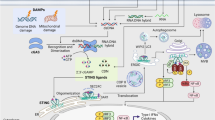Abstract
Our previous studies demonstrated that antiallergic effects of herbs such as clove and Magnoliae Flos (MF) resulted from the induction of apoptosis in mast cells. We here examined whether the antiallergic activity was caused by eugenol (4-allyl-2-methoxyphenol) which was one of major ingredients in the essential oils or extracts of numerous plants including clove and Magnoliae Flos. RBL-2H3 cells were treated with eugenol, and DNA electrophoresis, Western blotting, immunocytochemistry, confocal microscopy and immunoprecipitation were conducted. Effect of eugenol was tested using a rat anaphylaxis model. RBL-2H3 cells treated with eugenol showed typical apoptotic manifestations and translocation of p53 into mitochondria. Antisense p53 partially prevented the induction of apoptosis. Noticeably, we observed that p53 translocated into mitochondria was phosphorylated on ser 15. Phospho-ser 15-p53 physically interacted with Bcl-2 and Bcl-xL in mitochondria and its translocation into mitochondria preceded cytochrome c release and mitochondrial membrane potential (MMP) reduction. We also depicted that the survival of animals even after administration of the fatal dose of compound 48/80 might result from the decreased number of mast cells by eugenol pretreatment. In conclusion, eugenol induces apoptosis in mast cells via translocation of phospho-ser 15-p53 into mitochondria.
Similar content being viewed by others
References
Ohta K, Yamashita N. Apoptosis of eosinophils and lymphocytes in allergic inflammation. J Allergy Clin Immunol 1999; 104: 14–21.
Carson DA, Ribeiro JM. Apoptosis and disease. Lancet 1993; 341: 1251–1254.
Williams GT. Programmed cell death: Apoptosis and oncogenesis. Cell 1991; 65: 1097–1098.
Thornberry NA, Rosen A, Nicholson DW. Control of apoptosis by proteases. Adv In Pharmacol 1997; 41: 155–177.
Green DR, Reed JC. Mitochondria and apoptosis. Science 1998; 281: 1309–1312.
Hart PH. Regulation of the inflammatory response in asthma by mast cell products. Immunol Cell Biol 2001; 79: 149–153.
Bachert C. The role of histamine in allergic disease: Re-appraisal of its inflammatory potential. Allergy 2002; 57: 287–296.
Metcalfe DD, Mekori JA, Rottem M. Mast cell ontogeny and apoptosis. Exp Dermatol 1995; 4: 227–230.
Fuller R, Johnson M, Bye A. Fluticasone propionate-an update on preclinical and clinical experience. Res Pir Med 1995; 89: 3–18.
Park HI, Jeong MH, Lim YJ, et al. Szygium aromaticum (L.) Merr. Et Perry (Myrtaceae) flower bud induces apoptosis of p815 mastocytoma cell line. Life Sci 2001; 69: 553–556.
Kim GC, Lee SG, Park BS, et al. Magnoliae flos induces apoptosis of RBL-2H3 cells via mitochondria and caspase. Int Arch Allergy Immunol 2003; 131: 101–110.
IARC Monographs Evaluation of the carcinogenic risk of chemicals to humans. France: Lyon IARC Press, 1985; 36: 75.
Zhu YP. Materia Medica: Chemistry, Pharmacology and Applications Harwood. Amsterdam: Academic Publishers, 1996: 1
Cao Y, Cao R. Angiogenesis inhibited by drinking tea. Nature 1999; 398: 381.
Bai X, Cerimele F, Ushio-Fukai M, et al. Honokiol, a small molecular weight natural product, inhibits angiogenesis in vitro and tumor growth in vivo. J Biol Chem 2003; 278: 35501–35507.
Kim HM, Lee EH, Kim CY, et al. Antianaphylactic properties of eugenol. Pharmacol Res 1997; 36: 475–480.
Shin BK, Lee EH, Kim HM. Suppression of L-histidine decarboxylase mRNA expression by methyleugenol. Biochem Biophys Res Commun 1997; 232: 188–191.
Johnstone RW, Ruefli AA, Lowe SW. Apoptosis: A link between cancer genetics and chemotherapy. Cell 2002; 108: 153–164.
Nakano K, Vousden KH. PUMA, a novel proapoptotic gene, is induced by p53. Mol Cell 2001;7: 683–694.
Wagner AJ, Kokontis JM, Hay N. Myc-mediated apoptosis requires wild-type p53 in a manner independent of cell cycle arrest and the ability of p53 to induce p21waf1/cip1. Genes Dev 1994; 8: 2817–2830.
Marchenko ND, Zaika A, Moll UM. Death signal-induced localization of p53 protein to mitochondria. A potential role in apoptotic signaling. J Biol Chem 2000; 275: 16202–16212.
Mihara M, Erster S, Zaika A, et al. p53 has a direct apoptogenic role at the mitochondria. Mol Cell 2003; 11: 577–590.
Baptiste N, Prives C. p53 in the cytoplasm: A question of overkill. Cell 2004; 116: 487–489.
Author information
Authors and Affiliations
Corresponding author
Additional information
The contribution of Yeon Suk Song to the manuscript is equal to that of Bong Soo Park
Rights and permissions
About this article
Cite this article
Park, B.S., Song, Y.S., Yee, SB. et al. Phospho-ser 15-p53 translocates into mitochondria and interacts with Bcl-2 and Bcl-xL in eugenol-induced apoptosis. Apoptosis 10, 193–200 (2005). https://doi.org/10.1007/s10495-005-6074-7
Issue Date:
DOI: https://doi.org/10.1007/s10495-005-6074-7




